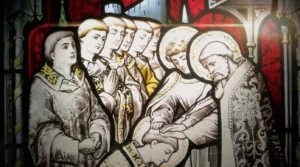“Must we always be killing each other? Don’t you realize that bitterness is the only result?” said Abner to Joab, as the sun went down. (from the battlefield at Gibeon, 2 Samuel 2:26)
We are people. And people, by definition, are broken. If we are followers of Jesus, we are saved by grace but we are broken, just the same.
The church, then, is nothing more than a collection of broken-but-redeemed people. Many of us come through the door of the church hurting, not yet sanctified. We bump into one another and create friction. It seems almost inevitable that in the church, just as in the world, there is conflict. As they say, hurt people hurt people.
Since the very beginning, conflict in the church has been part of the Christian experience. Surely God would prefer if it wasn’t that way, but that fact doesn’t erase reality. The early church understood this fact all too well. The letter Paul wrote to the people of Corinth was sent to one of the most divided, dysfunctional churches of the first century. Even Paul himself was not immune. When Paul and Barnabas made plans to go out on a second missionary journey (Acts 15), Barnabas wanted to take John Mark along. Paul was bitterly opposed. John Mark was the one who deserted them in Pamphylia on the first trip; if he was not able to withstand the pressures of real ministry, why rely on him again? Barnabas wanted to extend grace, but Paul dug his feet in. By the time their conflict reached its peak, they’d split. Barnabas and Mark set off in one direction, while Paul and his team went off in another.
How they worked through that conflict made all the difference in how God used them to impact the world for Christ. Acts 15:40 says that as they parted company, they commended one another to the service of the Lord.
Later on in another letter Paul would speak in defense of Barnabas (1 Corinthians 9:6) and he would work again with John Mark (2 Timothy 4:11). As a result (Acts 16:5), “the churches were strengthened in the faith and increased in numbers daily.”
Because they were willing to handle conflict creatively and gracefully, God was able to continue to work through them. It is likely that if Paul and Barnabas had separated bitterly and continued to backbite and harbor anger toward one another, neither of them would have been much use for God’s kingdom. But as it was, they were able to double their effectiveness while presenting a positive and mature approach to conflict within community.
What about us? Many of us have moved from one community of faith to another. For some, this was an easy move and healing came quickly. For others of us, though, hurts from the past will take time (even years) to heal. And it might be easy to believe there is nothing to be done about that.
Yet as Christians, we are given the ministry of reconciliation by Jesus Christ himself, who came expressly for that purpose. Maybe conflict in church is inevitable (remember – we are all broken), but healing can happen when we react creatively and graciously. In fact, as we saw with Paul and Barnabas, God can use both conflict and healing to further the Kingdom.
There are Christ-centered ways to deal with brokenness in all its forms. We can participate with Christ in healing after conflict. What practical steps can we take to find peace with the church we’ve left so we can bring a healthy spirit to the church we are ready to serve? A few ideas taken from my own experience as a pastor will follow in the next two posts.
Meanwhile, maybe these questions will help you process your own experience. Learning to process conflict is ultimately about building a healthy church culture. How are you participating in that process?
- Have you ever had a negative church experience? Are there any unresolved hurts from that experience that need to be acknowledged?
- Are you at peace with everyone in your church? How about with everyone in the church you left? Do you need to extend a gesture of grace to anyone?
- What are you doing in your current church or small group to promote mature, loving relationships?
This post is one of three in a series about how to navigate church relationships in the midst of conflict and change. Find part two here.








